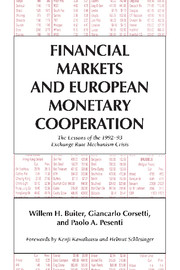 Financial Markets and European Monetary Cooperation
Financial Markets and European Monetary Cooperation Published online by Cambridge University Press: 06 July 2010
Introduction
In our view, most readings of the 1992–93 events miss the following crucial element: the ERM crackup has been the crisis of an exchange rate system, rather than the collapse of a collection of unilateral pegs individually pursued by a number of countries. The thesis we develop in this chapter is that the conclusions reached within the conceptual framework of the “unilateral peg” may be incomplete or misleading, since they both ignore the key role played by structural policy spillovers among European countries and overlook the effects of coordination (or lack thereof) of monetary and exchange rate policies within the system.
In this chapter and the next we argue that, while domestic private–public sector interactions are certainly an important part of the process that brought down the ERM, the 1992–93 crisis was in the first instance a conflict among monetary authorities and a failure of the European system as a policy coordination mechanism. In contrast to an approach that focuses exclusively on country-specific issues, ultimately only a systemic view is able to provide a comprehensive reading of the ERM crisis.
Our analysis thus fits the category of “fundamental” explanations, provided the set of fundamentals is augmented to include the cooperative (or noncooperative) design of monetary and exchange rate policies in the system, that is, to include the “rules of the game” that characterize the behavior of the Periphery countries and the Center vis-à-vis each other.
To save this book to your Kindle, first ensure no-reply@cambridge.org is added to your Approved Personal Document E-mail List under your Personal Document Settings on the Manage Your Content and Devices page of your Amazon account. Then enter the ‘name’ part of your Kindle email address below. Find out more about saving to your Kindle.
Note you can select to save to either the @free.kindle.com or @kindle.com variations. ‘@free.kindle.com’ emails are free but can only be saved to your device when it is connected to wi-fi. ‘@kindle.com’ emails can be delivered even when you are not connected to wi-fi, but note that service fees apply.
Find out more about the Kindle Personal Document Service.
To save content items to your account, please confirm that you agree to abide by our usage policies. If this is the first time you use this feature, you will be asked to authorise Cambridge Core to connect with your account. Find out more about saving content to Dropbox.
To save content items to your account, please confirm that you agree to abide by our usage policies. If this is the first time you use this feature, you will be asked to authorise Cambridge Core to connect with your account. Find out more about saving content to Google Drive.